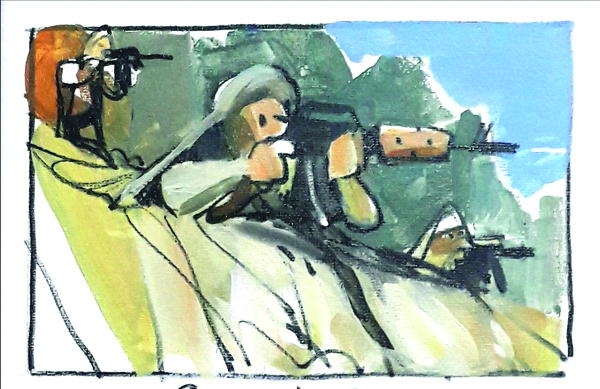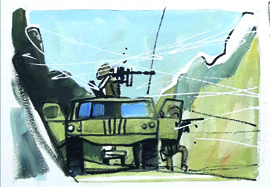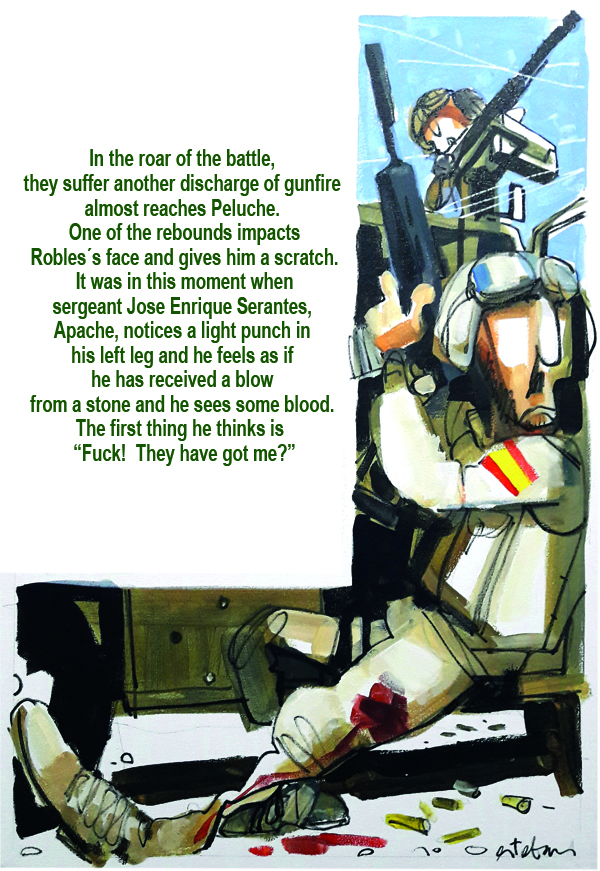Sabzak Pass
Some places are destined to be combat areas, where the battle never passes by. These places are determined to see the first and last bullets flying. These places—arteries of social contact, obliged route for travellers and goods—can never be ruled by extortioners, insurgents or warlords. These places seem to be spinning at the same pace as the planet, however, once in a while, time stops to shroud them in the loud noise of the battle. One of these places is Sabzak Pass in Afghanistan.

Sabzak Pass is an obliged transit point to reach Bala Murghab and the north area. It is the main artery that controls the whole land communication between Badghis and Herat. Inhabitants in this area would live in a permanent state of fear and with their economy permanently dwindled, since 2 September 2009, when time stopped in Sabzak Pass. Then, it began to be controlled by insurgents at the command of the Tajik leader Ishan Khan, mainly devoted to blackmailing and spreading fear in this strategic point.
In these valleys that ignore what living in peace is, these ports that are permanently chased by combats, the mission is clear—the Afghan Security Forces, supported by the Spanish Army, must take control of Sabzak Pass. They must free the whole territory from extortion and terror. So that is where Company 'Albuera' is heading, moving as a light shadow along former paths which were once ruled by arrows and swords, in order to see how time has stopped again.
The Weapons Section advances along a very complex territory. Sergeant Serantes' VAMTAC vehicle shows the way.
The Company divides into sections to cover the large area. The Captain, together with the First Section, begin the reconnaissance of the Hamam mines, area controlled by the insurgents. Once there, they start receiving fire from rockets and rifles. The old steel litany—which was iron before, bronze prior to that, and stone longer ago—can again be heard in Sabzak Pass, the key that connects North and South in Afghanistan.
At that time, the Captain—with the intention of cutting the insurgents' way of escaping—orders the Weapons Section to move towards the 'Asturias' support base—area located in the rearguard. Due to the series of events which open ways one had never considered touching, Sergeant José Enrique Serantes meets the commander of the Medium Mortars Squad.
The Weapons Section advances along a very complex territory. Sergeant Serantes' VAMTAC vehicle shows the way. The route gets narrower in intricate slopes to the extent that it becomes necessary for corporal Cabrera—nicknamed Peluche—to get off the vehicle to perform the reconnaissance on foot and find a place for the VAMTAC to drive along.
During the reconnaissance, platoon Cabrera receives two bursts of gunfire of unknown origin. He rushes to the vehicle to shelter himself. Once inside, he tells the heavy machine gun shooter—soldier Mosquera, nicknamed Panchi—to go back to his post, since he had previously relieved him in order to reduce fatigue caused by dust inhalation. Continuous support is key for success in a combat unit. Every soldier knows that.
Once up in the tower, corporal Cabrera—Peluche—reports that two insurgents are escaping on a motorbike. They are the ones who opened fire. After informing the chief of Section, they continue moving, knowing that taking Sabzak Pass is not going to be easy, since places stopped by time are always hard to conquer.
After communicating the incident, the Section deploys—opening the largest possible front to respond powerfully to the origin of the fire
'This has just begun'—said José Enrique to the thick air inside his vehicle, and immediately took the radio to inform of the news. 'Apache here, entering support base 'Asturias', receiving gunfire 12 o'clock from our position. We have responded with the heavy machine gun and continue moving looking for contact. We are reaching the height right opposite us with the 12.7 mm heavy machine gun. Accessing this altitude is impossible, since there is cliff the vehicle cannot access separating us from it. The insurgents are inside foxholes, covered with blankets to make it harder for us to find them'.
After communicating the incident, the Section deploys—opening the largest possible front to respond powerfully to the origin of the fire. José Enrique's—Apache—vehicle is still at the forefront and starts receiving fire 9 o'clock. Time had stopped, but now the hours abandon the passing of time and join the geographical features, forcing the Section to reorganise itself. Sergeant Peinado's—Gato—vehicle closes 9 o'clock and neutralises the threat responding with fire.
In order to reduce the distance with the enemy, the VAMTAC moves forward, until it reaches the the edge of the cliff—limit that can be exceeded. Simultaneously, Lieutenant Balsa's vehicle—chief of Section—starts receiving fire 3 o'clock. However, the quick response from the heavy machine gun manages to neutralise and suffocate enemy fire.

At that time, the heavy machine gun on the VAMTAC begins to suffer interrumptions, not allowing Peluche to fire one shot after another. When reducing the fire rate, the enemy focuses on the vehicle in the forefront, managing to crash several projectiles into it, so José Enrique decides to disembark and cover himself with the reinforced doors in order to respond to the HK assault rifles. By doing so, they manage to cover corporal Cabrera, while Peluche dismantles the machine gun. He has done it many times with his eyes closed, and he can do it now when the bullets are whistling
In the meantime, corporal Sandra Hermoso and the driver—soldier Robles—continue responding to the attack in turns, supporting their partners. When they run out of ammunition, as they use up the magazines, they shelter themselves inside the vehicle to supply again, realising that the rocky land and the valleys around it are made of iron.
Made of iron—as they themselves are now—as they defend themselves shooting an enemy that always maintains its efforts to move them away from Sabzak Pass.
The heavy machine gun keeps causing problems, so the chief of section—Lieutenant Balsa—orders the precision shooters to support them from their position. By doing this, they reduce the amount of fire impacting on the vehicles at the vanguard.
Immediately after, after taking the MG-42 machine gun, Panchi and Apache jump on a small natural cover and start providing covering fire so that Peluche can dismantle the machine gun, as it had got blocked again. Unfortunately for them, when it was most necessary, the heavy machine gun stopped working. However, these are the innumerable incidents that they have suffered during the manoeuvres—leaves, unused vehicles, weapons with ammunition... Nothing escapes to continuous training.
So they must get by with the light machine gun they keep inside the vehicle.
Meanwhile, Sandri—corporal Hermoso—inside the battle, is in charge of carrying more ammunition to the machine gun and correcting the shot, keeping the HK in her hand. Since writing is always linear, it just allows the possibility of describing punctual facts in combats. Nevertheless, we must imagine a moment full of noise, echoes from the radio, voice shouting to the wind and dust, land ploughed by boots and impacts, whistles from shots and bullets bouncing, that prefer moving instead of getting stuck in the land or a vehicle forever. The VAMTAC has two flat tyres, broken headlamps, broken glass,and more than 20 impacts—many of which have went through the panel.

In the heat of the battle, they suffer another heavy firing, that almost reaches Peluche. One of the bullet bounces crashes into Robles' face, getting a scratch on it. It is then when sergeant José Enrique Serantes—Apache—notices a sligh knock on his left leg, as if he had been hit with a stone. He looks at his leg and sees some blood coming out. What he first thinks is: 'Fuck, have they hit me?'.
They keep responding to the fire, and they report the situation. At that point, he feels strange when he hears on the radio: 'Apache has fallen'. And quickly, he thinks again: 'It's good to still be alive!'. Since we wants to be completely sure, he asks soldier Robles to take a look at his wound. Robles confirms that the hole is clean both in and outside. When he sits up, he feels slightly dizzy. He informs the Chief of Section of what has happened. He also tells him that they are running out of ammunition. It is then when the Chief of Section receives the order of breaking contact and reaching the 'Málaga' patrol base, about 10 kilometres away, so that the second Section can set up a helicopter landing area for evacuation. Right there, José Enrique is stabilised, as he waits to be evacuated to Herat.
At ROLE 2 in Herat, a surgeon from the Bulgarian Army performs an emergency operation on him. Before being anaesthetised, he thinks of how much he owes to his partners from 49th 'Tenerife', to the Air Force personnel that evacuated him, to Company 'Albuera', to the Weapons Section... When he is about to lose consciousness, he cannot help thinking about how close all the members from his squad and crew were to him, as if they were an only soldier, during the danger that surrounded them during the combats—Peluche, Sandri, Panchi, Robles and him—Apache, who cannot distinguish himself from the rest. 'Stay calm', he says to himself as he starts to lose consciousness due to the effect of anaesthetic. 'Pain is temporary, but glory is forever'.
ARMY UNITS
- Araba Álava |
- Albacete |
- Alicante |
- Almería |
- Asturias |
- Ávila |
- Badajoz |
- Barcelona |
- Burgos |
- Cáceres |
- Cádiz |
- Cantabria |
- Castellón |
- Ceuta |
- Ciudad Real |
- Córdoba |
- A Coruña |
- Cuenca |
- Girona |
- Granada |
- Guadalajara |
- Gipuzkoa |
- Huelva |
- Huesca |
- Islas Baleares |
- Jaén |
- León |
- Lleida |
- Lugo |
- Madrid |
- Málaga |
- Melilla |
- Murcia |
- Navarra |
- Ourense |
- Palencia |
- Las Palmas |
- Pontevedra |
- La Rioja |
- Salamanca |
- Segovia |
- Sevilla |
- Soria |
- Tarragona |
- Santa Cruz de Tenerife |
- Teruel |
- Toledo |
- Valencia |
- Valladolid |
- Bizkaia |
- Zamora |
- Zaragoza



